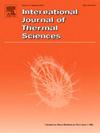Numerical investigation on heat transfer enhancement by integrally-molded double-sided spiral finned tubes for waste heat recovery
IF 4.9
2区 工程技术
Q1 ENGINEERING, MECHANICAL
International Journal of Thermal Sciences
Pub Date : 2025-01-13
DOI:10.1016/j.ijthermalsci.2025.109684
引用次数: 0
Abstract
An integrally-molded double-sided spiral finned (IDSF) tube has been proposed in this paper to improve the thermal-hydraulic performance of the tubular air preheater due to the lower heat transfer efficiency, which limits its application in large units above 350 MW during the deep peaking. The physical model of IDSF tubes was established, and numerical simulations of the internal and external flow and heat transfer performance under different structural parameters were conducted. The simulation results show that adding spiral fins inside the tube will decrease the thermal-hydraulic performance inside the tube while adding spiral fins outside the tube with reasonable fin structure and arrangement parameters can increase the thermal-hydraulic performance outside the tube, and thus double-sided thermal-hydraulic performance evaluation factors have been proposed to evaluate the operation economy and compactness of air preheaters based on the Nu, j and f factors inside and outside the tube. Results show that the fin inside the tube has a significant effect on the pressure drop when the fin pitch is smaller than 12 mm, and the tubes with the fin heights of 1.5 mm and 2.0 mm exhibit excellent thermal-hydraulic performance at the fin pitch of 12 mm. The f of the tube with the fin height of 1.5 mm is lower than that of the tube with the fin height of 2.0 mm, and the f of the tube with the fin height of 2.0 mm is about 1.28 times that of the fin height of 1.5 mm. The volume of the tubular air preheater can be reduced by a maximum of 43.1 %∼46.0 %, while the power consumption increases by 14.7 %∼17.6 % compared to the smooth tube. The power consumption of the tubular air preheater can be reduced by a maximum of 19 %∼21 % and its volume reduced by 15.7 %∼16.7 %. This work provides essential theoretical guidance and technical support for the design and application of air preheaters.
求助全文
约1分钟内获得全文
求助全文
来源期刊

International Journal of Thermal Sciences
工程技术-工程:机械
CiteScore
8.10
自引率
11.10%
发文量
531
审稿时长
55 days
期刊介绍:
The International Journal of Thermal Sciences is a journal devoted to the publication of fundamental studies on the physics of transfer processes in general, with an emphasis on thermal aspects and also applied research on various processes, energy systems and the environment. Articles are published in English and French, and are subject to peer review.
The fundamental subjects considered within the scope of the journal are:
* Heat and relevant mass transfer at all scales (nano, micro and macro) and in all types of material (heterogeneous, composites, biological,...) and fluid flow
* Forced, natural or mixed convection in reactive or non-reactive media
* Single or multi–phase fluid flow with or without phase change
* Near–and far–field radiative heat transfer
* Combined modes of heat transfer in complex systems (for example, plasmas, biological, geological,...)
* Multiscale modelling
The applied research topics include:
* Heat exchangers, heat pipes, cooling processes
* Transport phenomena taking place in industrial processes (chemical, food and agricultural, metallurgical, space and aeronautical, automobile industries)
* Nano–and micro–technology for energy, space, biosystems and devices
* Heat transport analysis in advanced systems
* Impact of energy–related processes on environment, and emerging energy systems
The study of thermophysical properties of materials and fluids, thermal measurement techniques, inverse methods, and the developments of experimental methods are within the scope of the International Journal of Thermal Sciences which also covers the modelling, and numerical methods applied to thermal transfer.
 求助内容:
求助内容: 应助结果提醒方式:
应助结果提醒方式:


